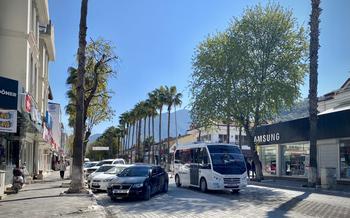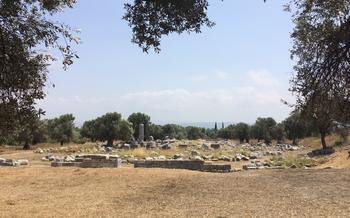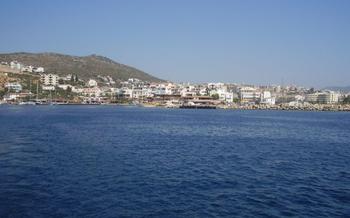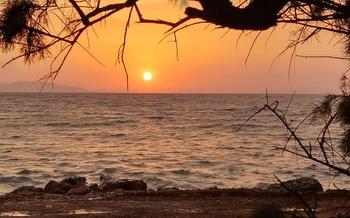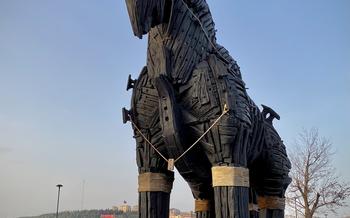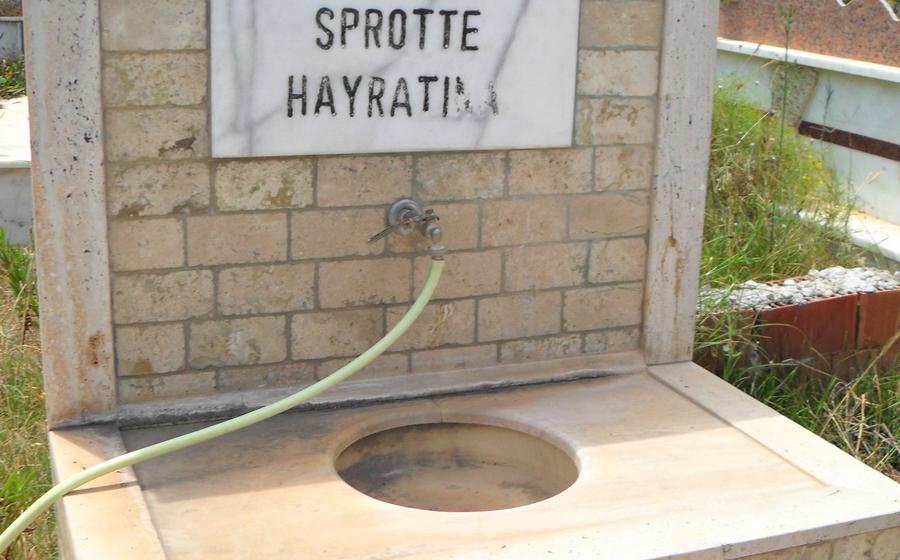
Ancient City of Triopion
- The Antiquity of Triopion
- Tips for Exploring Triopion Independently
- Myths and Legends
- Well-Preserved Ruins
- Agora and Market
- Temple of Apollo
- Theater and Odeon
- Fortifications and Gates
- Necropolis and Tombs
- Aqueduct and Water Systems
- Triopion's Connection to Knidos and Kos
- Olive Oil Production:
- Local Cuisine and Restaurants:
- Beaches and Coastal Beauty
- Accommodation and Where to Stay
- Insider Tip: Hidden Gems
The Antiquity of Triopion
Triopion, an ancient city located in the Datça peninsula, holds significant historical and archaeological importance. Its roots can be traced back to the 7th century BC when it was founded by Dorian Greeks. Triopion flourished as a maritime and trading center, owing to its strategic location on the Aegean coast. The city's name is believed to be derived from the mythical hero Triopas, who was associated with the founding of several cities in the region.
The ruins of Triopion are situated on a hill overlooking the picturesque harbor of Datça. The site is easily accessible by car or on foot from the town center. Visitors can explore the well-preserved remains of Triopion, including temples, theaters, fortifications, and an agora. These ruins offer a glimpse into the city's rich past and provide valuable insights into the architectural and cultural heritage of the ancient Greeks.
Tips for Exploring Triopion Independently
- Wear comfortable shoes as the site involves walking on uneven terrain.
- Bring water and sunscreen, especially during the hot summer months.
- Take your time to explore the ruins and appreciate the intricate details of the architecture.
- Read up on the history of Triopion before your visit to enhance your understanding of the site.
- If possible, visit during the shoulder seasons (spring or autumn) to avoid the crowds.
- Consider hiring a local guide for a more in-depth exploration of the ruins.
Myths and Legends
Triopion is steeped in ancient tales and legends that have been passed down through generations, adding a layer of enchantment to its ruins. One of the most famous myths associated with the city is the tale of Bellerophon and Pegasus. According to legend, Bellerophon, a hero from Corinth, arrived in Triopion on the winged horse Pegasus. With the help of Pegasus, Bellerophon slayed the fearsome Chimera, a monstrous creature with a lion's head, a goat's body, and a serpent's tail. The myth symbolizes the triumph of good over evil and the power of courage and determination.
Another legend connects Triopion to the epic Trojan War. It is said that the city's founder, Triopas, was a son of Heracles, the legendary Greek hero. Triopas is believed to have fought alongside the Greeks in the Trojan War, further solidifying Triopion's connection to this pivotal event in Greek mythology.
To enhance the visitor experience, interactive storytelling and immersive exhibits bring these myths and legends to life. Visitors can engage with interactive displays, listen to audio narrations, and watch short films that recreate the ancient tales and transport them back in time.
Well-Preserved Ruins
Triopion boasts an array of well-preserved ruins that offer a glimpse into its glorious past. Among the most notable structures are temples, theaters, and fortifications, each contributing to our understanding of the city's history and significance.
The Temple of Apollo, dedicated to the revered Greek god, stands as a testament to the city's religious devotion. Its grand architecture and intricate carvings provide insights into the artistic prowess of Triopion's artisans. The theater and odeon, once vibrant venues for entertainment and cultural performances, showcase the city's appreciation for the arts. Their impressive acoustics and well-preserved seating areas evoke the atmosphere of ancient theatrical productions.
The fortifications, including towering walls and strategic gates, reveal Triopion's strategic importance and its ability to withstand external threats. The sturdy construction techniques and the use of local materials highlight the city's engineering capabilities. Ongoing restoration and preservation efforts ensure that these ruins remain accessible and awe-inspiring for generations to come.
As you explore Triopion, remember to respect the historical significance of these ruins. Refrain from touching or climbing on the structures, and avoid disturbing the surrounding environment. By practicing responsible tourism, we can help preserve this ancient city for future visitors to appreciate and learn from.
Agora and Market
The agora, or marketplace, was the bustling heart of Triopion. It served as a central hub for trade, social interaction, and civic life. This vibrant space was lined with shops, stalls, and workshops, where merchants sold a variety of goods, from fresh produce and pottery to exotic spices and imported textiles.
The agora was not merely a place of commerce but also a center for political and social gatherings. It was here that citizens met to discuss important issues, vote on laws, and celebrate festivals. The agora's vibrant atmosphere reflected the diverse cultural influences that shaped Triopion, with people from across the region coming together to trade, exchange ideas, and forge relationships.
Excavations at the agora have unearthed a wealth of artifacts that provide valuable insights into the daily life and economy of Triopion. These include coins, pottery fragments, tools, and even remnants of food and drink. By studying these artifacts, archaeologists have been able to piece together a vivid picture of the bustling marketplace, where the sounds of haggling, laughter, and the clinking of coins filled the air.
To truly experience the spirit of ancient Triopion, stand in the center of the agora and let your imagination transport you back in time. Picture the stalls laden with colorful goods, the merchants calling out their wares, and the citizens engaged in lively conversation and debate. Close your eyes and listen for the echoes of laughter and the hum of activity that once filled this vibrant space.
Temple of Apollo
Among the well-preserved ruins of Triopion, the Temple of Apollo stands out as the most prominent religious structure. Its majestic facade and intricate architectural details transport visitors back to a time when the city was a thriving center of worship and devotion. Constructed in the 6th century BC, the temple was dedicated to Apollo, the Greek god of music, poetry, and prophecy. Its grand scale and elaborate ornamentation reflect the importance of Apollo's cult in ancient Triopion.
The temple's design follows the classical Greek style, featuring a rectangular floor plan surrounded by rows of imposing columns. The exterior walls are adorned with exquisite carvings and reliefs depicting scenes from Greek mythology and religious rituals. Inside the temple, visitors can marvel at the well-preserved altar and the remnants of a colossal statue of Apollo that once stood guard over the sanctuary.
The Temple of Apollo holds a special place in the history of Triopion. It served as a focal point for religious ceremonies, festivals, and oracles. Devotees from across the region would flock to the temple to seek guidance and blessings from the revered deity. The temple's influence extended beyond religious matters, as it also played a significant role in the city's political and economic life.
As visitors explore the ruins of the Temple of Apollo, they can't help but be awed by the enduring legacy of this sacred site. It stands as a testament to the architectural prowess and religious devotion of the ancient Triopians, offering a glimpse into the spiritual heart of this once-thriving metropolis.
Theater and Odeon
Triopion's cultural and entertainment life flourished within its well-preserved theater and odeon. The theater, with its impressive seating capacity, hosted a variety of performances, from tragedies and comedies to musical concerts. Its acoustics, designed to carry the actors' voices to every corner of the auditorium, create an immersive experience for the audience.
The odeon, a smaller venue, served as a more intimate setting for recitals, poetry readings, and chamber music. Its intricate acoustics, optimized for musical performances, allowed for a pure and resonant sound to fill the space.
Today, these ancient venues continue to inspire awe and wonder. While no longer hosting the original performances of antiquity, they serve as reminders of Triopion's rich cultural heritage. Visitors can wander through the tiers of seats, imagining the vibrant atmosphere of a live performance, and appreciate the architectural details that have stood the test of time.
Initiatives are underway to preserve and restore these iconic structures, ensuring their legacy lives on for future generations. The theater and odeon of Triopion stand as testaments to the city's enduring cultural spirit, inviting travelers to step into a world where art and entertainment once thrived.
Fortifications and Gates
Triopion's strategic location on the Datça Peninsula necessitated the construction of sturdy fortifications to protect its inhabitants from potential attacks. These fortifications, which were built using local stone and impressive engineering techniques, consisted of massive walls that encircled the city. The walls were reinforced with towers and gates, each serving a specific purpose. The gates, which were the main entry and exit points of the city, were particularly impressive. They were not only functional but also architectural marvels, showcasing the city's wealth and power. The intricate designs, sturdy construction, and strategic placement of these gates are a testament to the skill and ingenuity of Triopion's ancient builders. Exploring these fortifications and gates offers a glimpse into the city's defensive capabilities and provides a deeper understanding of Triopion's role in the region's history.
Necropolis and Tombs
Triopion's necropolis, located outside the city walls, offers a glimpse into the funerary practices and beliefs of its ancient inhabitants. Various types of tombs have been discovered, including rock-cut chamber tombs, vaulted tombs, and sarcophagi. These tombs range in size and complexity, reflecting the social status and wealth of the deceased. Archaeological excavations have revealed a wealth of artifacts, including pottery, jewelry, and coins, providing valuable insights into the lives and customs of Triopion's citizens.
The necropolis is a poignant reminder of the city's rich history and its connection to the afterlife. Visitors can explore the tombs and imagine the rituals and ceremonies that took place within them. The inscriptions and carvings on the tombs offer glimpses into the lives and personalities of those buried there.
By exploring the necropolis, travelers gain a deeper understanding of the ancient worldview and the significance of death and remembrance in Triopion. It is a place to reflect on the enduring legacy of this ancient city and the lives of its people.
Aqueduct and Water Systems
Triopion's water supply was secured by an impressive aqueduct, a testament to the city's advanced engineering skills. Constructed with meticulous precision, the aqueduct stretched for several kilometers, channeling water from distant springs to the heart of the city. Its design incorporated a gentle slope, allowing water to flow smoothly and consistently.
The aqueduct's construction involved the use of sturdy materials, primarily stone and terracotta pipes. These pipes, carefully fitted together, formed a continuous conduit, ensuring a reliable water supply. The aqueduct's strategic placement ensured that water was distributed effectively throughout the city, reaching public fountains, baths, and private residences.
The importance of water management in ancient Triopion cannot be overstated. Access to a clean and consistent water supply was crucial for the city's hygiene, sanitation, and overall well-being. The aqueduct played a vital role in maintaining public health and preventing the spread of waterborne diseases.
Moreover, the aqueduct's presence allowed for the development of elaborate water features, such as fountains and pools, which added to the city's aesthetic appeal and provided recreational opportunities for its inhabitants. The practical aspects of water usage were also carefully considered, with public fountains strategically placed to ensure easy access for all citizens.
Triopion's Connection to Knidos and Kos
Triopion tapestry of historical and cultural connections. These three cities shared a common thread of mythology, trade, and political alliances, forming a vibrant network of ancient civilizations.
Mythology and Legends: In the realm of mythology, Triopion, Knidos, and Kos were intertwined through shared tales and legends. The myth of Bellerophon and Pegasus, for instance, had strong ties to all three cities. Bellerophon, a hero from Corinth, traveled to Lycia, where he encountered the winged horse Pegasus. With Pegasus's help, he slew the monstrous Chimera and performed other heroic feats. These legends connected the cities through a shared mythological heritage.
Trade and Commerce: Triopion, Knidos, and Kos played crucial roles in the maritime trade networks of the ancient world. Their strategic locations along the Aegean Sea facilitated the exchange of goods, ideas, and cultures. The cities traded agricultural products, textiles, pottery, and other commodities, contributing to the economic prosperity of the region.
Political Alliances: In the political arena, Triopion, Knidos, and Kos formed alliances and confederations to protect their shared interests. They united against common threats, such as invading armies or rival city-states. These alliances ensured stability and cooperation, fostering a sense of regional unity and strength.
Combined Itineraries: For modern-day travelers, exploring Triopion in conjunction with Knidos and Kos offers a unique opportunity to delve into the interconnected history of these ancient cities. Visitors can easily combine these destinations into a single itinerary, creating a comprehensive journey through the rich cultural heritage of the Aegean.
Olive Oil Production:
Triopion and the surrounding region have a rich history of olive oil production, dating back to ancient times. The fertile soils and favorable climate of the area have made it an ideal place for olive cultivation for centuries. Traditional methods of olive oil production are still practiced in Datça, using stone mills and presses to extract the oil from the olives. Visitors can witness these traditional techniques and learn about the history of olive oil making in the region. Olive oil tasting experiences are also available, allowing visitors to sample the local olive oils and appreciate their unique flavors and aromas. Culinary enthusiasts can indulge in local cuisine that incorporates fresh, locally produced olive oil, savoring the authentic tastes of the region.
Local Cuisine and Restaurants:
Datça and the surrounding region offer a diverse range of traditional Turkish dishes, each bursting with flavor and showcasing the culinary heritage of the country. Near the ancient city of Triopion, visitors can find a variety of restaurants serving up authentic Turkish cuisine, allowing them to savor the local gastronomy while immersing themselves in the history of the region.
Must-try dishes include "meze" platters, an array of small appetizers that tantalize the taste buds and offer a glimpse into Turkish culinary traditions. Fresh seafood is another highlight, with grilled fish and octopus being local specialties. For a taste of traditional Turkish flavors, try "pide," a boat-shaped flatbread topped with various fillings, or "köfte," succulent meatballs made with a blend of spices.
When searching for culinary gems, venture beyond the main tourist areas to discover hidden gems frequented by locals. These unassuming eateries often serve the most authentic and delicious dishes, providing a true taste of Turkish home cooking.
To fully immerse yourself in the local cuisine, consider taking a cooking class and learning the secrets of Turkish culinary arts from skilled chefs. These classes offer a hands-on experience, allowing you to create your own Turkish dishes and gain a deeper appreciation for the flavors and techniques that define this rich cuisine.
Beaches and Coastal Beauty
Beyond the historical allure of Triopion, Datça boasts a stunning coastline and pristine beaches that beckon visitors to bask in the Mediterranean sun. After exploring the ancient ruins, indulge in the pleasures of swimming, sunbathing, and various water sports against the backdrop of picturesque landscapes. Capture Instagram-worthy shots of the turquoise waters, golden sands, and rugged cliffs that define the region's natural beauty. Combine your journey through history with a refreshing beach day, creating a harmonious blend of culture and relaxation.
Accommodation and Where to Stay
Datça offers a range of accommodation options to suit every budget and preference, ensuring a comfortable and convenient stay for visitors exploring the ancient city of Triopion. For those seeking proximity to the historical site, the charming town of Datça, just a short drive away, provides a variety of hotels, guesthouses, and vacation rentals. Within walking distance of Triopion, travelers can find cozy pensions and boutique hotels offering stunning views and easy access to the ruins.
Budget-conscious travelers will find affordable options in hostels and guesthouses, providing a social and lively atmosphere. For a more luxurious experience, boutique hotels and resorts offer modern amenities, private balconies, and breathtaking views of the surrounding landscape. Whether seeking a simple place to rest or a lavish retreat, Datça's accommodation options cater to every traveler's needs.
When choosing a place to stay, consider factors such as proximity to Triopion, desired amenities, and budget. Booking in advance, especially during peak tourist season, is recommended to secure the best deals and availability. Embrace the opportunity to immerse yourself in the local culture by opting for family-run guesthouses or traditional Turkish houses, offering a unique and authentic experience.
Insider Tip: Hidden Gems
Beyond the main attractions, Triopion holds hidden gems waiting to be discovered by curious travelers. Off the beaten path, you can find secluded corners, panoramic viewpoints, and intriguing ruins that offer a deeper glimpse into the city's past. Explore the lesser-known temples, such as the Temple of Artemis, nestled amidst olive groves, or uncover the secrets of the ancient cistern, which once provided water to the city. For a unique perspective, climb to the top of the old watchtower for breathtaking views of the surrounding landscape. These hidden gems offer a chance to connect with the authentic spirit of Triopion and create lasting memories of your visit.

